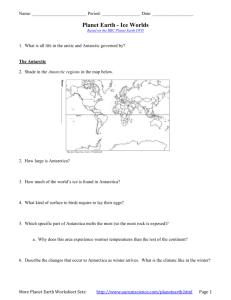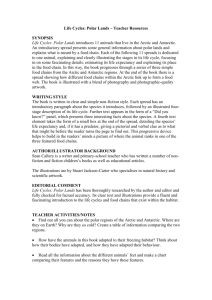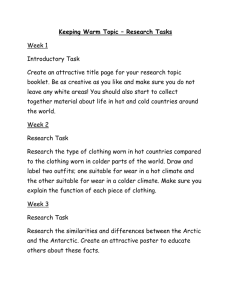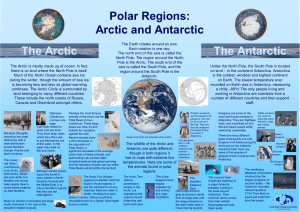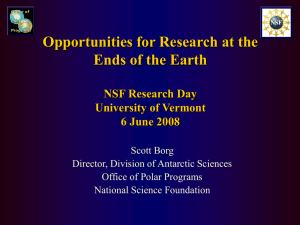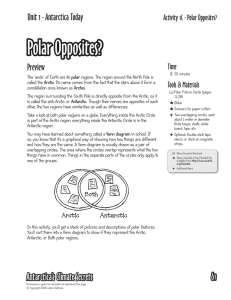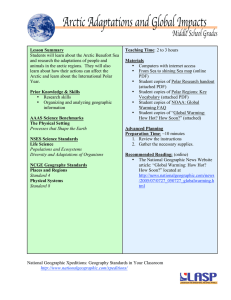Additional time may be necessary for completion of poster presentations.
advertisement
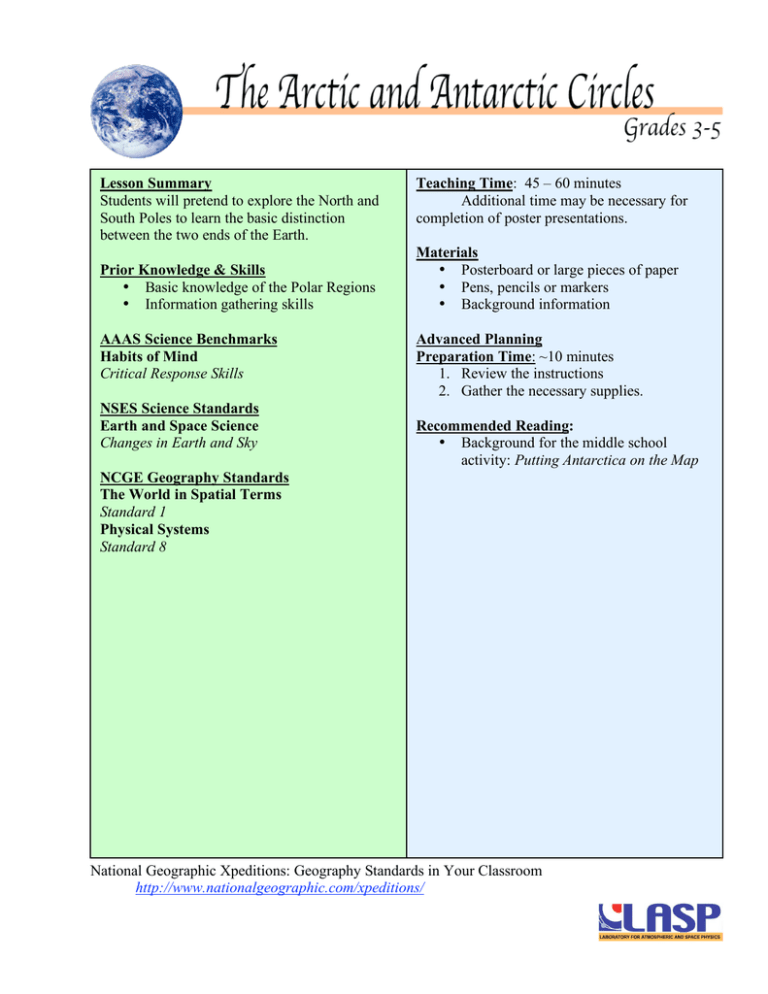
Lesson Summary Students will pretend to explore the North and South Poles to learn the basic distinction between the two ends of the Earth. Prior Knowledge & Skills • Basic knowledge of the Polar Regions • Information gathering skills AAAS Science Benchmarks Habits of Mind Critical Response Skills NSES Science Standards Earth and Space Science Changes in Earth and Sky Teaching Time: 45 – 60 minutes Additional time may be necessary for completion of poster presentations. Materials • Posterboard or large pieces of paper • Pens, pencils or markers • Background information Advanced Planning Preparation Time: ~10 minutes 1. Review the instructions 2. Gather the necessary supplies. Recommended Reading: • Background for the middle school activity: Putting Antarctica on the Map NCGE Geography Standards The World in Spatial Terms Standard 1 Physical Systems Standard 8 National Geographic Xpeditions: Geography Standards in Your Classroom http://www.nationalgeographic.com/xpeditions/ Activities - Xpeditions @ nationalgeographic.com Check out: X5: Satellite Spyglass The Arctic and Antarctic Circles The Arctic and Antarctic Circles - K-2: A Vacation To The Polar Regions - 3-5: Expedition To The Poles - 6-8: What Do People Know About The Arctic and Antarctic? - 9-12: Environmental Issues in the Polar Regions << Scientists search for secrets in Antarctica, where the ocean partially solidifies into pancake– shaped ice formations. Photograph by Maria Stenzel - Standard #5: That People Create Regions to Interpret Earth's Complexity XTRAS // - News Story: Overdue Honor for an Arctic Explorer. - Photos: Many polar animals blend in with their surroundings! - Map: The Arctic and Antarctic Circles are both polar zones. - Dive into great stories that can tell you much more. INTERACTIVE FEATURES // - Webcam: Watch elephant seals live from California! (Elephant seals are also found in Antarctica). LINKS // Click for more great links related to this activity. Your Mission Explore the ends of the Earththe Polesto compare and contrast each region. Briefing The North and South Poles have lured explorers for over a century. While both of these regions are mysterious, fascinating, and of course cold, they have a number of important differences. The Arctic, where the North Pole is, is an ocean surrounded by landmasses. Here, you might find animal life such as polar bears, reindeer, and foxes. While many people think snow when they hear "Arctic," in fact much of the Arctic is tundra (treeless plains characterized by low shrubs; black, mucky soil; and, deeper down, permanently frozen soil) and boreal forest (woodlands made up mostly of evergreen trees and shrubs that bear cones, such as pine cones). A wide variety of plant life can survive in the Arctic, including mosses, lichens, and hundreds of flowering plants. By contrast, the Antarctic, where the South Pole is found, is a continent surrounded by oceans. While the Arctic is cold, the Antarctic is even colderonly 2 percent of it is not covered by ice. Temperatures there have been recorded as low as -128.6 º F, (-89.22 º C)! It is so cold that there are only two species of flowering plants that can survive. But many animals live here, such as penguins and many species of seals and whales, including the orca, or killer whale. So are you up for the challenge? Get your gear packed and your (warm!) parka zipped. Be sure to take lots of pictures and keep your notes in a journal. You have some pretty big snowshoes to fill, since explorers like Ernest Shackleton and Robert Peary have ventured http://www.nationalgeographic.com/xpeditions/activities/05/index.html (1 of 2) [7/31/07 1:04:49 PM] Activities - Xpeditions @ nationalgeographic.com before you. Perhaps they missed something. What will you discover? FAMILY-X FILES Younger Xpeditioners: Decide whether you would rather head to the North or South Pole. After your "visit," create a poster based on what you discover. Be sure to include information on the animals and terrain that you would find only on the ocean or continent that you have selected. Once you are finished, head in the other direction and create a poster based on what you encounter on the other end of the Earth. Share your posters with your family and friends. Older Xpeditioners: Environmentalists worry about the effect that ozone depletion will have on our planet. Without the ozone layer people are vulnerable to the ultraviolet rays of the sun, which damage the skin. Ultraviolet radiation also causes negative effects on plants and marine ecosystems. Your task is to create an advertising campaign suggesting things that you and your friends can do to prevent ozone depletion. Share your ideas with your family, classmates, and friends. Parents: Discuss with your children some of the actions that your family has taken to keep our water and air clean. Some of the chores that children are already doing, such as separating recyclables, may be great for the environment, but your child might not understand why. Help him or her understand how his or her actions affect the Earth. © 2001 National Geographic Society. All rights reserved. http://www.nationalgeographic.com/xpeditions/activities/05/index.html (2 of 2) [7/31/07 1:04:49 PM]
